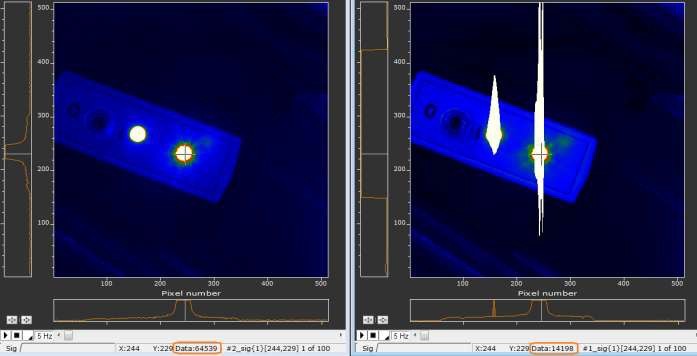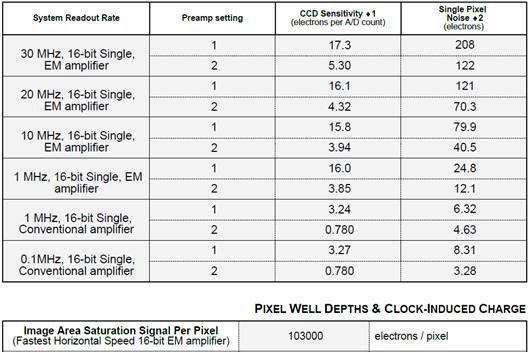Resources
 Part of the Oxford Instruments Group
Part of the Oxford Instruments Group
Expand
Collapse
 Part of the Oxford Instruments Group
Part of the Oxford Instruments Group
Depending on the configuration of a CCD camera, the sensor may appear to saturate at either the pixel well or the analogue-to-digital converter (ADC).
The well depth of a pixel is the maximum amount of charge that can be held before saturating. When the charge in a pixel exceeds the saturation limit (or well depth), the charge will overflow into adjacent pixels, this is known as ‘blooming’ [1]. When the pixel is saturating and blooming, the linear response of the CCD will start to deviate and compromise the quantitative performance. Larger pixels will have lower spatial resolution but greater well capacity and offer higher dynamic range which can be important for some applications.
The maximum digital bit depth (represented as ADU or counts) of a given pixel will be dependent on the amplifier or analogue to digital converter. Most commonly, a 16-bit amplifier is used to convert the incident charge to digital counts. Therefore, at 16-bit, the maximum bit depth available will be 65535 counts (or 216).

Figure 1: Left - Image Showing 16-bit A/D converter saturation Right - Image showing pixel well depth exceeded resulting in 'blooming' effect
Whether the A/D converter or pixel saturates first will depend on the camera configuration which in turn will determine the CCD sensitivity [2][3]. Andor provide an individual System Performance sheet with every camera that includes the sensitivity values for each readout and preamplifier gain configuration specific to that camera. If you do not have the System Performance Sheet, please contact your local Andor Support Representative [4] with the camera serial number.
Figure 2 below shows an extract from a Performance Sheet for an iXon Ultra 888 camera. The pixel saturation limit (or well depth) for this camera is 103000 electrons per pixel as stated in its system performance sheet.

Figure 2: Extract from a typical System Performance Sheet for an Andor iXon Ultra 888
Using this data, the saturation limit can be determined.
For example:
Conversely, using a higher sensitivity option, for example 1 MHz & PAG 2 (Conventional Amplifier) where the sensitivity is 0.78 e-/ADU, the saturation limit will be limited by the 16-bit ADC (or 65535 counts) rather than the pixel well.
Effects of pixel binning
On-sensor pixel binning will increase the pixel well depth by a factor of the number of pixels being binned (i.e. 2x2 binning will increase the well depth by a factor of 4) at the expense of spatial resolution. The A/D converter will remain a limitation when pixel binning.
If you require further information or assistance, please contact your local Andor Product Support representatives [4].
Useful links
